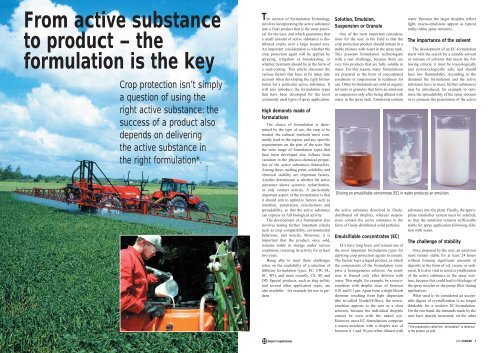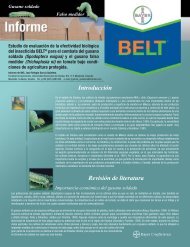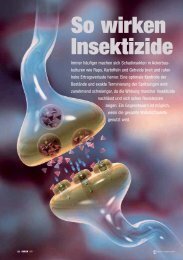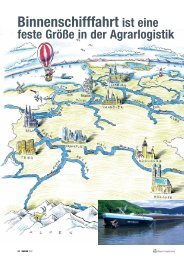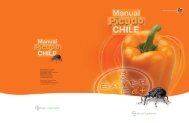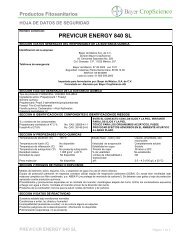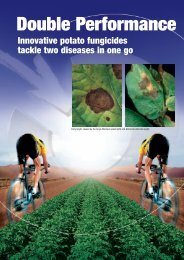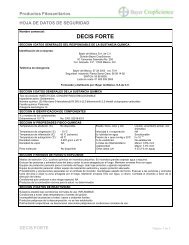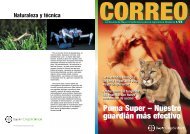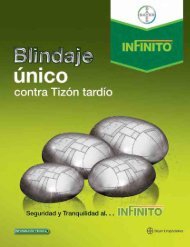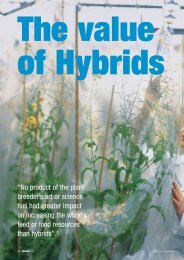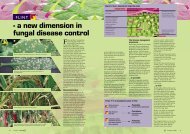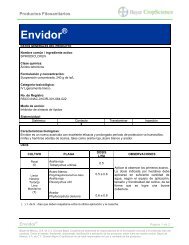From active substance to product â the formulation is the key - Bayer ...
From active substance to product â the formulation is the key - Bayer ...
From active substance to product â the formulation is the key - Bayer ...
You also want an ePaper? Increase the reach of your titles
YUMPU automatically turns print PDFs into web optimized ePapers that Google loves.
<strong>From</strong> <strong>active</strong> <strong>substance</strong><strong>to</strong> <strong>product</strong> – <strong>the</strong><strong>formulation</strong> <strong>is</strong> <strong>the</strong> <strong>key</strong>Crop protection <strong>is</strong>n’t simplya question of using <strong>the</strong>right <strong>active</strong> <strong>substance</strong>: <strong>the</strong>success of a <strong>product</strong> alsodepends on delivering<strong>the</strong> <strong>active</strong> <strong>substance</strong> in<strong>the</strong> right <strong>formulation</strong>*.The science of Formulation Technologyinvolves incorporating <strong>the</strong> <strong>active</strong> <strong>substance</strong>in<strong>to</strong> a final <strong>product</strong> that <strong>is</strong> <strong>the</strong> most practicalfor <strong>the</strong> user, and which guarantees thata small amount of <strong>active</strong> <strong>substance</strong> <strong>is</strong> d<strong>is</strong>tributedevenly over a large treated area.An important consideration <strong>is</strong> whe<strong>the</strong>r <strong>the</strong>crop protection agent will be applied byspraying, irrigation or broadcasting, orwhe<strong>the</strong>r treatment should be in <strong>the</strong> form ofa seed-coating. Th<strong>is</strong> article d<strong>is</strong>cusses <strong>the</strong>various fac<strong>to</strong>rs that have <strong>to</strong> be taken in<strong>to</strong>account when developing <strong>the</strong> right <strong>formulation</strong>for a particular <strong>active</strong> <strong>substance</strong>. Itwill also introduce <strong>the</strong> <strong>formulation</strong> typesthat have been developed for <strong>the</strong> mostcommonly used types of spray application.High demands made of<strong>formulation</strong>sThe choice of <strong>formulation</strong> <strong>is</strong> determinedby <strong>the</strong> type of use, <strong>the</strong> crop <strong>to</strong> betreated, <strong>the</strong> cultural methods most commonlyused in <strong>the</strong> region, and any specificrequirements on <strong>the</strong> part of <strong>the</strong> user. But<strong>the</strong> wide range of <strong>formulation</strong> types thathave been developed also follows fromvariation in <strong>the</strong> physico-chemical propertiesof <strong>the</strong> <strong>active</strong> <strong>substance</strong>s <strong>the</strong>mselves.Among <strong>the</strong>se, melting point, solubility andchemical stability are important fac<strong>to</strong>rs.Ano<strong>the</strong>r determinant <strong>is</strong> whe<strong>the</strong>r <strong>the</strong> <strong>active</strong><strong>substance</strong> shows systemic red<strong>is</strong>tribution,or only contact activity. A particularlyimportant aspect of <strong>the</strong> <strong>formulation</strong> <strong>is</strong> thatit should aim <strong>to</strong> optimize fac<strong>to</strong>rs such asretention, penetration, rain-fastness andspreadability, so that <strong>the</strong> <strong>active</strong> <strong>substance</strong>can express its full biological activity.The development of a <strong>formulation</strong> alsoinvolves testing fur<strong>the</strong>r important criteriasuch as crop compatibility, environmentalbehaviour, and <strong>to</strong>xicity. Moreover, it <strong>is</strong>important that <strong>the</strong> <strong>product</strong>, once sold,remains stable in s<strong>to</strong>rage under variousconditions, retaining its activity for at leasttwo years.Being able <strong>to</strong> meet <strong>the</strong>se challengesrelies on <strong>the</strong> availability of a selection ofdifferent <strong>formulation</strong> types: EC, EW, SL,SC, WG, and more recently, CS, SE andOD. Special <strong>product</strong>s, such as slug pelletsand several o<strong>the</strong>r application types, arealso available – for example for use in gardens.Solution, Emulsion,Suspension or GranuleOne of <strong>the</strong> most important considerationsfor <strong>the</strong> user in <strong>the</strong> field <strong>is</strong> that <strong>the</strong>crop protection <strong>product</strong> should remain in astable mixture with water in <strong>the</strong> spray tank.Th<strong>is</strong> presents <strong>formulation</strong> technolog<strong>is</strong>tswith a real challenge, because <strong>the</strong>re arevery few <strong>product</strong>s that are fully soluble inwater. For th<strong>is</strong> reason, many <strong>formulation</strong>sare prepared in <strong>the</strong> form of concentratedemulsions or suspensions in readiness foruse. O<strong>the</strong>r <strong>formulation</strong>s are sold as organicsolvents or granules that form an emulsionor suspension only after being diluted withwater in <strong>the</strong> spray tank. Emulsions containwater. Because <strong>the</strong> larger droplets reflectlight, macro-emulsions appear as typicalmilky-white spray mixtures.The importance of <strong>the</strong> solventThe development of an EC-<strong>formulation</strong>starts with <strong>the</strong> search for a suitable solven<strong>to</strong>r mixture of solvents that meets <strong>the</strong> followingcriteria: it must be <strong>to</strong>xicologicallyand eco<strong>to</strong>xicologically safe, and shouldhave low flammability. According <strong>to</strong> <strong>the</strong>demands <strong>the</strong> <strong>formulation</strong> and <strong>the</strong> <strong>active</strong><strong>substance</strong> have <strong>to</strong> meet, fur<strong>the</strong>r <strong>substance</strong>smay be introduced, for example <strong>to</strong> optimize<strong>the</strong> spreadability of <strong>the</strong> spray mixtureor <strong>to</strong> promote <strong>the</strong> penetration of <strong>the</strong> <strong>active</strong>Diluting an emulsifiable concentrate (EC) in water produces an emulsion.<strong>the</strong> <strong>active</strong> <strong>substance</strong> d<strong>is</strong>solved in finelyd<strong>is</strong>tributedoil droplets, whereas suspensionscontain <strong>the</strong> <strong>active</strong> <strong>substance</strong> in <strong>the</strong>form of finely-d<strong>is</strong>tributed solid particles.Emulsifiable concentrates (EC)ECs have long been, and remain one of<strong>the</strong> most important <strong>formulation</strong> types forapplying crop protection agents <strong>to</strong> cereals.The farmer buys a liquid <strong>product</strong>, in which<strong>the</strong> components of <strong>the</strong> <strong>formulation</strong> compr<strong>is</strong>ea homogeneous solution. An emulsion<strong>is</strong> formed only after dilution withwater. Th<strong>is</strong> might, for example, be a microemulsionwith droplet sizes of between0.01 and 0.1 µm. Apart from a slight blu<strong>is</strong>hshimmer resulting from light d<strong>is</strong>persion(<strong>the</strong> so-called Tyndall-Effect), <strong>the</strong> microemulsionappears <strong>to</strong> <strong>the</strong> user as a clearsolution, because <strong>the</strong> individual dropletscannot be seen with <strong>the</strong> naked eye.However, most EC-<strong>formulation</strong>s compr<strong>is</strong>ea macro-emulsion with a droplet size ofbetween 0.1 and 10 µm when diluted with<strong>substance</strong> in<strong>to</strong> <strong>the</strong> plant. Finally, <strong>the</strong> appropriateemulsifier system must be selected,so that <strong>the</strong> emulsion remains sufficientlystable for spray application following dilutionwith water.The challenge of stabilityOnce prepared by <strong>the</strong> user, an emulsionmust remain stable for at least 24 hourswithout forming significant amounts ofdeposits in <strong>the</strong> form of oil, cream, or sediment.It <strong>is</strong> also vital <strong>to</strong> avoid crystallizationof <strong>the</strong> <strong>active</strong> <strong>substance</strong> in <strong>the</strong> spray mixture,because th<strong>is</strong> could lead <strong>to</strong> blockage of<strong>the</strong> spray nozzles or <strong>the</strong> pump filter duringapplication.What used <strong>to</strong> be considered an acceptabledegree of crystallization <strong>is</strong> no longerthinkable for a modern EC-<strong>formulation</strong>.On <strong>the</strong> one hand, <strong>the</strong> demands made by <strong>the</strong>user have sharply increased; on <strong>the</strong> o<strong>the</strong>r* The preparation called <strong>the</strong> „<strong>formulation</strong>“ <strong>is</strong> identical<strong>to</strong> <strong>the</strong> <strong>product</strong> as sold.1/05 COURIER 7
hand, modern application equipment andapplication methods require emulsions of<strong>the</strong> highest quality in order <strong>to</strong> allow <strong>the</strong>crop protection agent <strong>to</strong> be d<strong>is</strong>tributedevenly across <strong>the</strong> treated field. A fur<strong>the</strong>rconsideration <strong>is</strong> that <strong>the</strong> quality criteria for<strong>the</strong> reg<strong>is</strong>tration of new <strong>product</strong>s havebecome significantly more stringent.Careful with mixtures!All <strong>formulation</strong> types have <strong>to</strong> be testedfor <strong>the</strong>ir m<strong>is</strong>cibility with o<strong>the</strong>r crop protection<strong>product</strong>s, fertil<strong>is</strong>ers and additives,because <strong>the</strong>y must retain <strong>the</strong>ir biologicalactivity and crop compatibility in mixtureswith <strong>the</strong>se <strong>product</strong>s. Each individual <strong>formulation</strong><strong>is</strong> a finely-tuned „system“ initself. Mixing <strong>formulation</strong>s in <strong>the</strong> spraytank inevitably leads <strong>to</strong> various degrees ofunfavourable interaction between <strong>the</strong> inertingredients present in <strong>the</strong> different <strong>formulation</strong>s.At worst, gel-formation, coagulationor sedimentation can make <strong>the</strong> spraymixture <strong>to</strong>tally unusable. Th<strong>is</strong> places <strong>the</strong>onus on users <strong>to</strong> restrict <strong>the</strong>mselves <strong>to</strong> mixturesthat have been fully tested and validated.Soluble liquids (SL)The water-soluble, liquid concentrates(Soluble Liquids), like <strong>the</strong> EC and EW,contain <strong>the</strong> <strong>active</strong> <strong>substance</strong> in d<strong>is</strong>solved<strong>formulation</strong>s. Never<strong>the</strong>less, localized concentrationof <strong>the</strong> <strong>product</strong> can lead <strong>to</strong> somedegree of crystallization if <strong>the</strong> spray mixture<strong>is</strong> not properly stirred.Emulsions in Water (EW)EW-<strong>formulation</strong>s are emulsions inwater. The emulsion can compr<strong>is</strong>e a liquid<strong>active</strong> <strong>substance</strong>, or o<strong>the</strong>rw<strong>is</strong>e one that hasbeen d<strong>is</strong>solved in solvents. Th<strong>is</strong> means thatconsiderably less solvent <strong>is</strong> applied <strong>to</strong> <strong>the</strong>crop compared with EC-<strong>formulation</strong>s.With an EW, <strong>the</strong> emulsion has already beenestabl<strong>is</strong>hed in <strong>the</strong> sold <strong>product</strong>, and <strong>is</strong> onlydiluted in <strong>the</strong> spray mixture. EW-<strong>formulation</strong>shave <strong>the</strong> advantage that <strong>the</strong>y show littletendency <strong>to</strong> form crystals in <strong>the</strong> spraymixture. EWs can also be in <strong>the</strong> form ofei<strong>the</strong>r micro- and macro-emulsions.However, EW-<strong>formulation</strong>s are uncommon,because few <strong>active</strong> <strong>substance</strong>s areliquids or possess <strong>the</strong> suitable solubilityproperties.Suspension concentrates (SC)In SC-<strong>formulation</strong>s, <strong>the</strong> <strong>active</strong> <strong>substance</strong><strong>is</strong> present as a solid that <strong>is</strong> finelyd<strong>is</strong>tributedin particles of between 1 and 4µm in size. The particles are held in suspensionin <strong>the</strong> water-based mediumthrough <strong>the</strong> addition of so-called d<strong>is</strong>persingagents; th<strong>is</strong> effect involves mutualMixing a suspension concentrate (SC) with water produces a suspension. The <strong>active</strong> <strong>substance</strong> <strong>is</strong>present as finely-d<strong>is</strong>tributed particles.means that its biological availability <strong>is</strong>lower than with EC, EW and SL <strong>formulation</strong>s.Th<strong>is</strong> <strong>is</strong> why SCs are most suitablewhen a high degree of contact exposure of<strong>the</strong> host organ<strong>is</strong>m <strong>is</strong> <strong>the</strong> main aim.Water d<strong>is</strong>persible granules (WG)For insoluble <strong>active</strong> <strong>substance</strong>s, wettablepowders (WP) used <strong>to</strong> be <strong>the</strong> preferred<strong>formulation</strong> type; however, <strong>the</strong>setend <strong>to</strong> form dust and are difficult <strong>to</strong> doseout. Nowadays, <strong>the</strong>se problems are solvedby choosing water d<strong>is</strong>persible granules.These are dust-free in practice, and allow<strong>the</strong> inclusion of large amounts of <strong>active</strong><strong>substance</strong> in <strong>the</strong> <strong>product</strong>, so WGs are particularlyuseful for <strong>active</strong> <strong>substance</strong>s thatneed <strong>to</strong> be applied at high rates. In th<strong>is</strong>way, even if <strong>product</strong>ion costs are relativelyhigh, <strong>the</strong> cost per hectare can usually bekept down. WGs generally show good cropcompatibility, so <strong>the</strong>y are often used formore sensitive crops, such as grapevine.Suspoemulsions (SE)A suspoemulsion <strong>is</strong> a combination of <strong>the</strong>SC and EW <strong>formulation</strong> types. The continuousphase compr<strong>is</strong>es water, in which bothsolid particles and emulsion droplets arefinely d<strong>is</strong>tributed. Th<strong>is</strong> <strong>formulation</strong> type <strong>is</strong>especially suitable wherever two <strong>active</strong><strong>substance</strong>s with starkly contrasting solubilityprofiles or melting points need <strong>to</strong> bemixed. The emulsion phase can also containadditives that promote <strong>the</strong> systemicactivity of <strong>the</strong> <strong>active</strong> <strong>substance</strong>.Oil d<strong>is</strong>persions (OD)Many (new) systemic <strong>active</strong> <strong>substance</strong>scannot be formulated as ECs because of<strong>the</strong>ir particular properties. Because <strong>the</strong>optimal activity of <strong>the</strong>se <strong>active</strong> <strong>substance</strong>sStirring water-d<strong>is</strong>persable granules (WG) in<strong>to</strong> water makes <strong>the</strong>m spread spontaneously.depends on <strong>the</strong>ir entering <strong>the</strong> plant, alternativesare needed in which <strong>the</strong> <strong>active</strong> <strong>substance</strong><strong>is</strong> present in solid form. TheFormulation Technology Unit at <strong>Bayer</strong>CropScience has developed various conceptsinvolving oil d<strong>is</strong>persions (OD) inorder <strong>to</strong> achieve <strong>the</strong> required levels of biologicalactivity and crop compatibility. Inan OD, a solid <strong>active</strong> <strong>substance</strong> <strong>is</strong> suspendedin an oil. The oil also serves as acarrier for additives and/or a safener.Diluting <strong>the</strong> OD in water can produce variousspray mixtures: if <strong>the</strong> <strong>active</strong> <strong>substance</strong><strong>is</strong> itself water-soluble (as in many herbicides),<strong>the</strong>n an emulsion results; if <strong>the</strong><strong>active</strong> <strong>substance</strong> shows low water solubility(as in many insecticides), a suspoemulsionresults.OutlookIn <strong>the</strong> context of <strong>the</strong> steadily increasingdemands of modern crop protection, new,optimized variations on ex<strong>is</strong>ting <strong>formulation</strong>types – and of course new concepts –D<strong>is</strong>solving a soluble concentrate (SL) in water results in a clear solution.form. However, SLs differ from ECs andEWs in that every component of <strong>the</strong> <strong>formulation</strong><strong>is</strong> d<strong>is</strong>solved in <strong>the</strong> water-basedspray mixture – which <strong>is</strong> why <strong>the</strong> latter <strong>is</strong>always a clear solution. Th<strong>is</strong> means thatSL-<strong>formulation</strong>s can only be developed for<strong>active</strong> <strong>substance</strong>s that are sufficientlywater-soluble. A minimum spray mixturevolume <strong>is</strong> usually recommended for SL-repellency between <strong>the</strong> particles; and incombination with o<strong>the</strong>r <strong>substance</strong>s thatform net-like structures, <strong>the</strong> d<strong>is</strong>persingagents also prevent sediments from forming.One d<strong>is</strong>advantage though <strong>is</strong> that <strong>the</strong><strong>product</strong>’s high v<strong>is</strong>cosity generally makes itmore difficult <strong>to</strong> empty <strong>the</strong> packagingcompletely. The fact that <strong>the</strong> <strong>active</strong> <strong>substance</strong><strong>is</strong> present in crystalline form alsoCapsule suspensions (CS)Capsule Suspensions are <strong>the</strong> best choiceif an <strong>active</strong> <strong>substance</strong> shows problems withstability, or needs <strong>to</strong> be released in <strong>the</strong>environment in a controlled manner. The<strong>active</strong> <strong>substance</strong> can be present within <strong>the</strong>capsule ei<strong>the</strong>r d<strong>is</strong>solved or d<strong>is</strong>persed in <strong>the</strong>liquid phase. The internal phase of <strong>the</strong> capsule<strong>is</strong> usually a solvent. The capsule <strong>is</strong>present in <strong>the</strong> <strong>product</strong> and later, in <strong>the</strong>spray mixture, in suspension. A CS <strong>is</strong>made from an emulsion that already contains<strong>the</strong> <strong>active</strong> <strong>substance</strong>; <strong>the</strong> o<strong>the</strong>r component<strong>is</strong> <strong>the</strong> capsule wall, <strong>the</strong> character<strong>is</strong>ticsof which determine <strong>the</strong> release kineticsof <strong>the</strong> CS <strong>formulation</strong>.Mixing an oil d<strong>is</strong>persion (OD) with water results in a suspoemulsion.will always be required. Th<strong>is</strong> <strong>is</strong> <strong>the</strong> taskassumed by <strong>the</strong> Formulation TechnologyUnit at <strong>Bayer</strong> CropScience. Formulationtechnology <strong>is</strong> an interd<strong>is</strong>ciplinary scientificundertaking, with special relationships <strong>to</strong><strong>the</strong> d<strong>is</strong>ciplines of colloid chem<strong>is</strong>try andinterfacial physics, in which technicalchem<strong>is</strong>try plays an essential role.In one of <strong>the</strong> next <strong>is</strong>sues of Courier, youwill be able <strong>to</strong> read about how efficientmodern spray applications can be, and how<strong>formulation</strong> technology can improve <strong>the</strong>d<strong>is</strong>tribution of <strong>the</strong> <strong>active</strong> <strong>substance</strong>s on,and within, <strong>the</strong> plant. ■8 COURIER 1/05 1/05 COURIER 9


